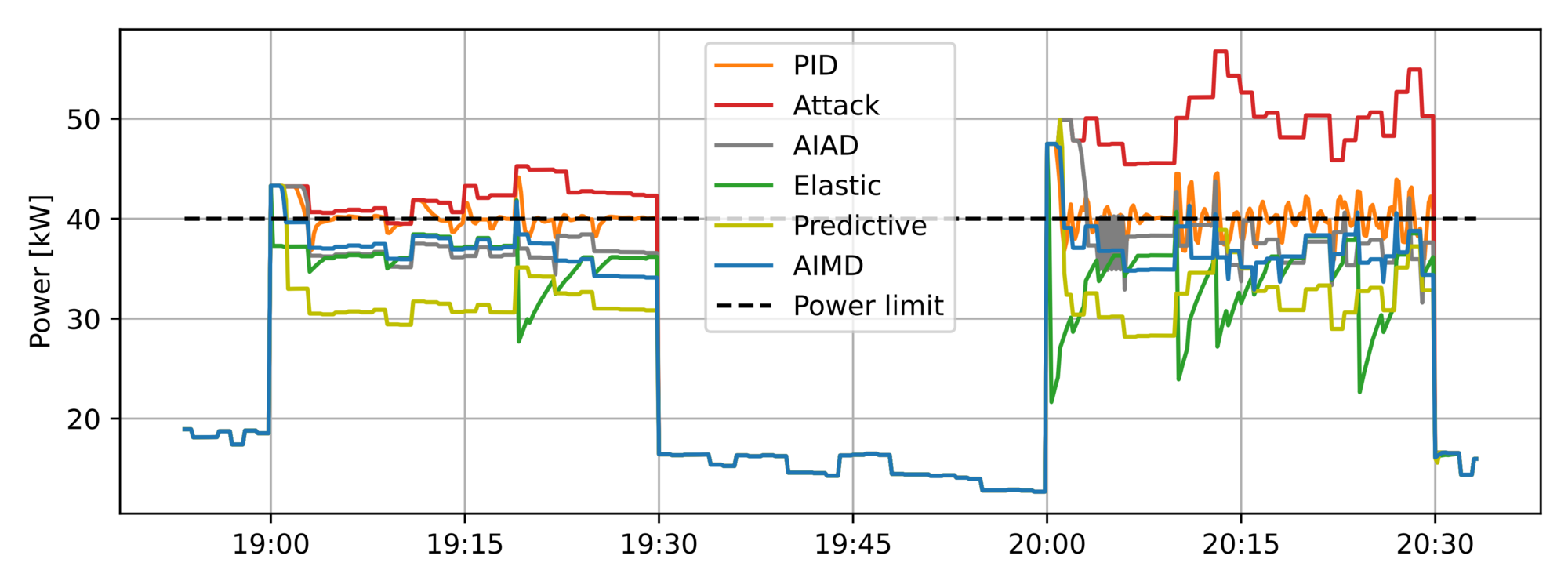GridShield: The future of electric vehicle charging
In the future, we expect most people will drive in electric vehicles daily and, as a result, charge them daily. Our power grid is not designed to handle the load of these vehicles. Therefore, ElaadNL proposed the idea of GridShield [1], a robust backup system that can prevent grid congestion and blackouts in areas where many vehicles charging simultaneously are causing overloads.
Introduction
Driving an electric vehicle (EV) feels like driving in the future. The seemingly effortless power delivery and incredible smoothness, coupled with extreme comfort due to the lack of a noisy internal combustion engine (ICE), make the dinosaur-powered predecessors of EVs feel like they date from before the era where Tyrannosaurus rex still walked our Earth.
These are all amazing aspects of EVs, and I certainly believe they are (part of) the solution to our climate change problems. They are, however, not perfect. Their main issue is inherent to driving vehicles of more than 1.5 meters wide at speeds well in excess of 100 km/h: they required great quantities of energy. Where ICE vehicles solved this problem by quickly onboarding energy in the form of fuel at a petrol station, EVs rely on charging and, if needed, fast charging. Therein lies the problem I would like to investigate with you in this short piece of text.
You see, to get their energy, EV chargers use the same infrastructure that provides energy for the lights in the room you are currently sitting in. That infrastructure, our electricity grid, was never made to accommodate EVs. One EV that is charging has the same power consumption as 10 complete households. Now imagine every household h in a neighborhood has an EV, and they are all charging. The grid load goes up from h to the equivalent of h+10h=11h households. All these EVs charging at the same time causes overloads, something we call grid congestion. This can ultimately result in blackouts.
Gridshield
Systems are being developed for smart charging, where the EVs are charged in such a way that congestion is prevented. However, such a system can fail, which introduces the need for a backup mechanism to such a system. GridShield, the mechanism I worked on for my Master thesis, does exactly that.
The basic idea of GridShield is displayed in Figure 1 [2]. A GridShield transmitter device is installed at a transformer and measures its load. When an overload is detected, it sends out a GridShield message through a stand-alone GridShield network, which uses one-way communication for robustness. At the chargers of the EVs, GridShield receiver modules are installed that use the received signal to reduce the charging power of the EVs connected to them. If all is right, the transmitter should then be able to measure a reduced load after the message was received.
![Figure 1: Schematic overview of the basic implementation of GridShield (GS) [2].](GridShieldSetup.png)
Figure 1: Schematic overview of the basic implementation of GridShield (GS) [2].
This idea sounds quite simple, because it is! However, the devil is in the details. While we want to reduce the power to prevent overloads, we also want to deliver as much power as we can within the limits, to prevent empty batteries after hours of charging.
Method
This tradeoff was the true subject of my thesis. To get it right, we investigated multiple GridShield algorithms to optimize the GridShield power reduction for both goals as shown in Figure 2. We considered PID control, developed proprietary algorithms, but what worked best was to implement an AIMD algorithm. Those that did the Network Systems module might recognize AIMD from TCP, a protocol used for virtually all Internet traffic. Turns out, sending packets over the internet is quite a similar challenge to the challenge that GridShield presents!

Figure 2: Total transformer power in the simulation scenario. Red is the Attack power, grey the original GridShield implementation, and blue and green show the AIMD and improved AIMD results
Results and conclusion
Figure 2 shows how different GridShield simulations perform in a cyber-attack scenario, where the EVs are forced to alternatingly charge at very high and at zero power. The interested reader is referred to [3] for more implementations, results, and seeing GridShield implemented in the real world. We see that the GridShield implementations can properly limit the charging power to remain below the maximum grid capacity. The best performing Elastic algorithm (which is derived from AIMD) can reduce congestion by almost 90% at a cost of only 16.48% energy not served in the simulation scenario. This makes GridShield a promising system for the prevention of blackouts in our EV future.
References
[1] https://elaad.nl/projecten/smoothems-met-gridshield/
[2] F. Tangerding, I. A. M. Varenhorst, G. Hoogsteen, M. E. T. Gerards and J. L. Hurink, “GridShield: A Robust Fall-Back Control Mechanism for Congestion Management in Distribution Grids,” 2022 IEEE PES Innovative Smart Grid Technologies Conference Europe (ISGT-Europe), 2022, pp. 1-5, doi: 10.1109/ISGT-Europe54678.2022.9960301.
[3] I.A.M. Varenhorst, “GridShield: Robust Control Algorithms to Prevent Power Outages,” MSc Dissertation, EEMCS, Univ. of Twente, Enschede, 2022.
